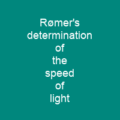Discovering the Speed of Light: The Ingenious Work of Ole Rømer
Imagine a time when the very nature of light was a mystery, a question that had puzzled thinkers for centuries. Enter Ole Christensen Rømer, a Danish astronomer who, in 1676, made a groundbreaking discovery that would change our understanding of the universe forever.
From Aarhus to Paris: The Journey Begins
Rømer was born on September 25, 1644, in Aarhus, where his merchant father and alderman mother laid the foundation for a life filled with curiosity and innovation. His journey took him to the University of Copenhagen, where he studied mathematics and astronomy, setting the stage for his future contributions.
The Royal Observatory: Where Light Meets Science
At the Royal Observatory in Paris, Rømer worked alongside some of the brightest minds of his time. It was here that he made a discovery that would challenge the very fabric of scientific thought. In 1676, while observing the moons of Jupiter, he noticed something peculiar: the duration of their eclipses varied depending on Earth’s position in its orbit around the sun.
Light Travels at a Finite Speed
Rømer’s observations led him to conclude that light travels at a finite speed. This was no small feat; it was like discovering that the river of time has banks, and not everything can flow through it instantaneously. He presented his findings to the French Academy of Sciences but did not publish them himself, leaving others like Christiaan Huygens to calculate the speed of light from his data.
More Than Just a Speed Demon
Rømer was more than just an astronomer; he was also an inventor. He developed various devices, including the first street lights in Copenhagen and contributed significantly to improving navigation by determining the speed of light. His work extended beyond astronomy into practical applications that benefited society.
From Street Lights to Calendar Reforms
In 1681, Rømer returned to Denmark where he was appointed professor of astronomy at the University of Copenhagen. He made several contributions, including introducing a national system for weights and measures in Denmark and persuading the king to adopt the Gregorian calendar.
A Life Well-Lived
Rømer served as the second Chief of the Copenhagen Police until his death on September 19, 1710. He left behind a legacy that includes rules for building new houses and improving the city’s infrastructure. His work in astronomy and invention has been honored through various memorials and awards.
The Ole Rømer Medal
Today, the Ole Rømer Medal is given annually to recognize outstanding research, while the Ole Rømer Museum in Denmark showcases his contributions to science. His work has even found its way into popular culture, with references in comic books, novels, and games.

Conclusion
Ole Christensen Rømer’s legacy is a testament to the power of curiosity and innovation. His discovery that light travels at a finite speed opened up new avenues in our understanding of the universe, much like how a single thread can weave together the fabric of reality. Through his work, we continue to explore the mysteries of the cosmos, inspired by the pioneering spirit of Rømer.
You want to know more about Rømer?
This page is based on the article Rømer published in Wikipedia (retrieved on March 11, 2025) and was automatically summarized using artificial intelligence.







